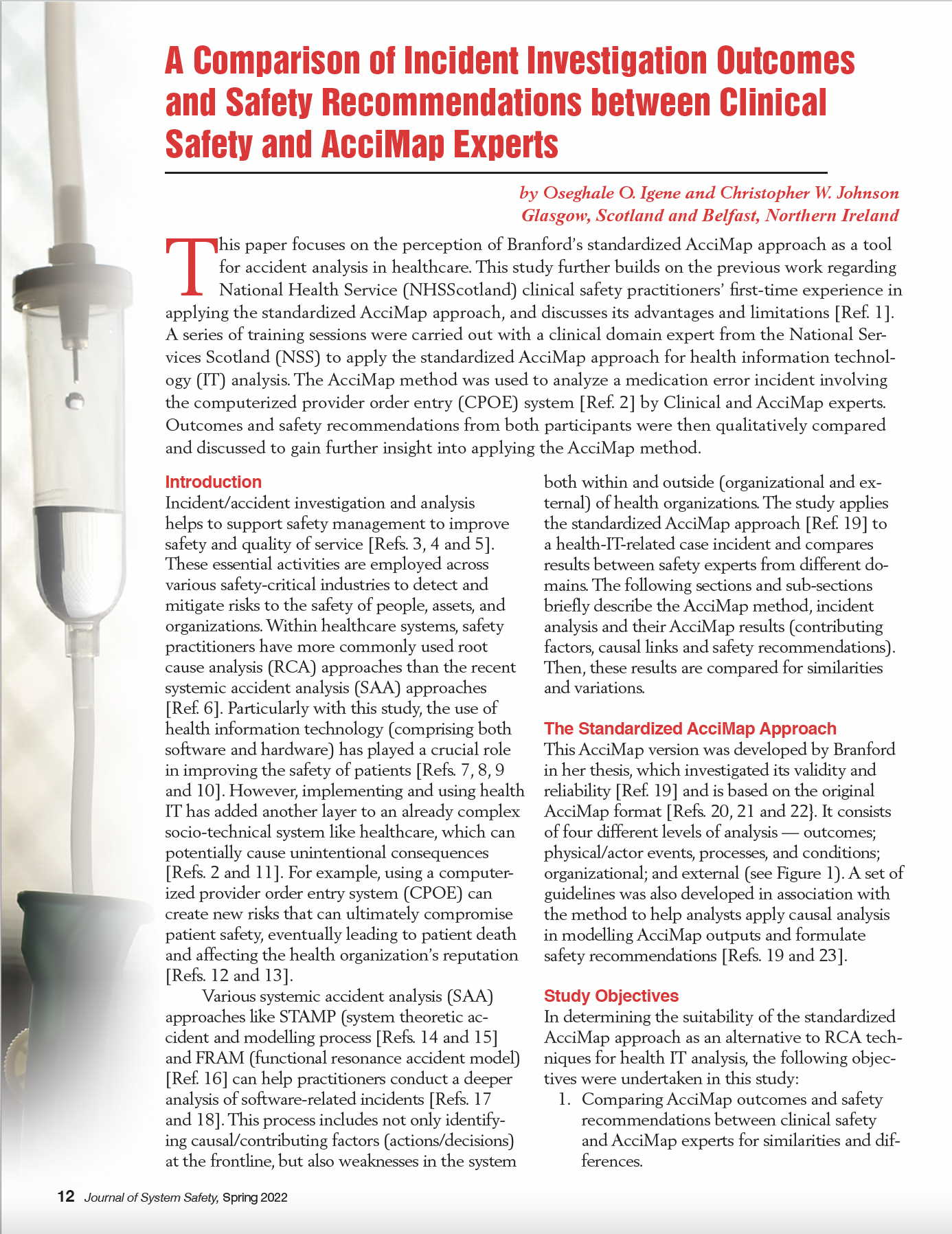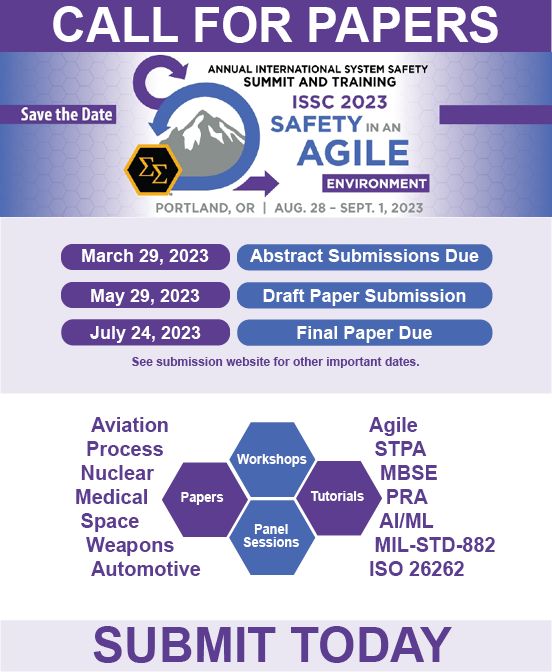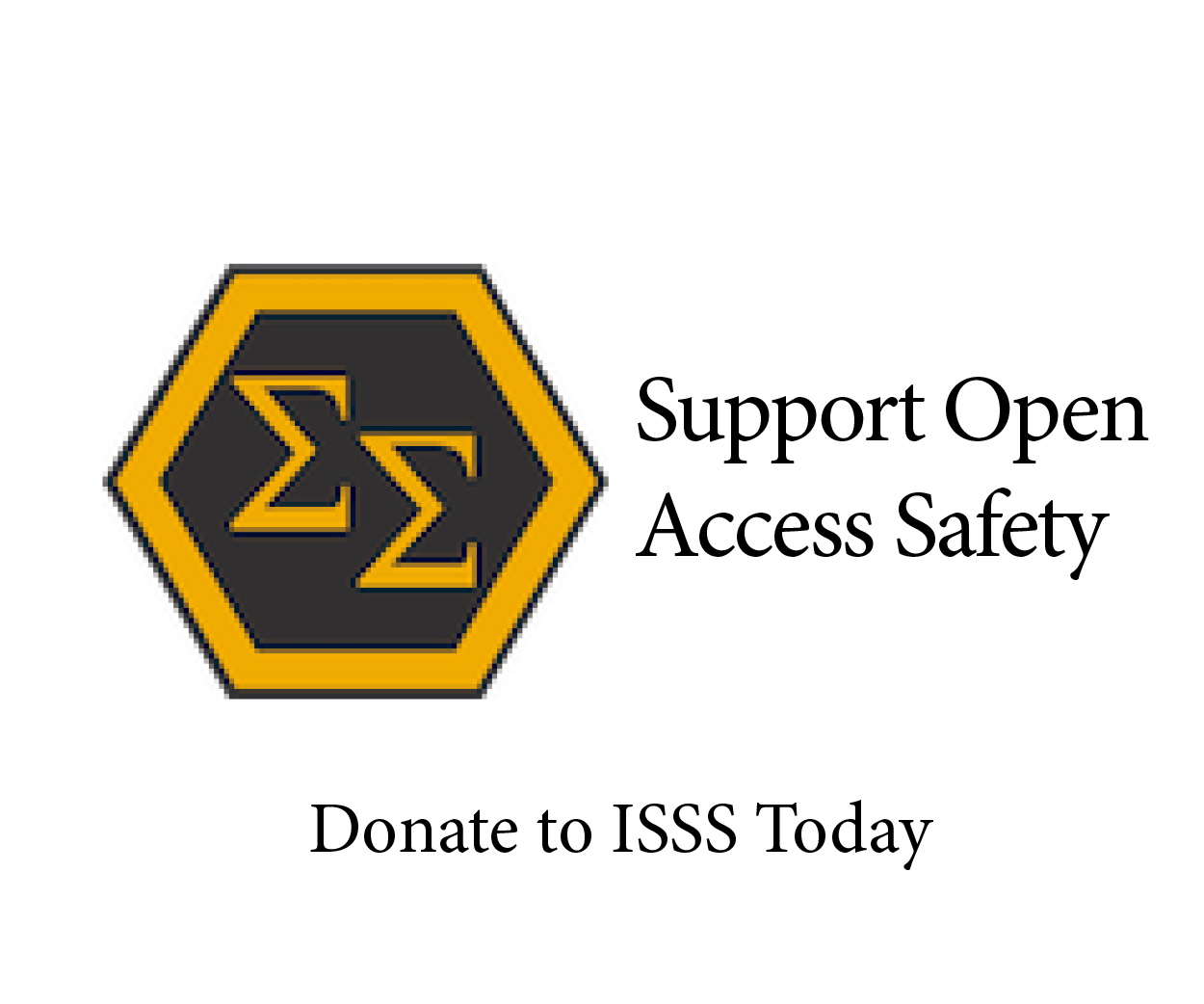A Comparison of Incident Investigation Outcomes and Safety Recommendations between Clinical Safety and AcciMap Experts
DOI:
https://doi.org/10.56094/jss.v57i2.190Keywords:
healthcare, AcciMap, causal analysis, clinical safetyAbstract
This paper focuses on the perception of Branford’s standardized AcciMap approach as a tool for accident analysis in healthcare. This study further builds on the previous work regarding National Health Service (NHSScotland) clinical safety practitioners’ first-time experience in applying the standardized AcciMap approach, and discusses its advantages and limitations [Ref. 1]. A series of training sessions were carried out with a clinical domain expert from the National Services Scotland (NSS) to apply the standardized AcciMap approach for health information technology (IT) analysis. The AcciMap method was used to analyze a medication error incident involving the computerized provider order entry (CPOE) system [Ref. 2] by Clinical and AcciMap experts. Outcomes and safety recommendations from both participants were then qualitatively compared and discussed to gain further insight into applying the AcciMap method.
References
Igene, O.O., C.W. Johnson, and J. Long, J. "An evaluation of the formalised AcciMap approach for accident analysis in healthcare," Cognition, Technology & Work, 1, p. 3, 2021. https://doi.org/10.1007/s10111-021-00669-w DOI: https://doi.org/10.1007/s10111-021-00669-w
Horsky, J., G.J. Kuperman, and V.L. Patel. "Comprehensive analysis of a medication dosing error related to CPOE," Journal of the American Medical Informatics Association, 12(4), pp. 377-382, 2005. https://doi.org/10.1197/jamia.M1740 DOI: https://doi.org/10.1197/jamia.M1740
Woloshynowych, M., S. Rogers, S. Taylor-Adams, and C. Vincent. "The investigation and analysis of critical incidents and adverse events in healthcare," Health Technology Assessment, National Co-ordinating Centre for HTA, 2005. https://doi.org/10.3310/hta9190 DOI: https://doi.org/10.3310/hta9190
Cacciabue, P.C. and G. Vella. "Human factors engineering in healthcare systems: The problem of human error and accident management," International Journal of Medical Informatics, 79(4), pp. e1-e17, 2010. https://doi.org/10.1016/j.ijmedinf.2008.10.005 DOI: https://doi.org/10.1016/j.ijmedinf.2008.10.005
Pillay, M. "Accident causation, prevention and safety management: A review of the State-of-the-Art," Procedia Manufacturing, 3, pp. 1838-1845, 2015. https://doi.org/10.1016/j.promfg.2015.07.224 DOI: https://doi.org/10.1016/j.promfg.2015.07.224
Canham, A., G. Thomas Jun, P. Waterson, and S. Khalid. "Integrating systemic accident analysis into patient safety incident investigation practices," Applied Ergonomics, 72, pp. 1-9, 2018. https://doi.org/10.1016/j.apergo.2018.04.012 DOI: https://doi.org/10.1016/j.apergo.2018.04.012
Koppel, R., J.P. Metlay, A. Cohen, B. Abaluck, A.R. Localio, S.E. Kimmel and B.L. Strom. "Role of computerised physician order entry systems in facilitating medication errors," Journal of the American Medical Association, 293(10), pp. 1197-1203, 2005. https://doi.org/10.1001/jama.293.10.1197 DOI: https://doi.org/10.1001/jama.293.10.1197
Ash, J.S., D.F. Sittig, R.H. Dykstra, K. Guappone, J.D. Carpenter, and V. Seshadri. "Categorising the unintended socio-technical consequences of computerised provider order entry," International Journal of Medical Informatics, 76(SUPPL. 1), pp. S21-S27, 2007. https://doi.org/10.1016/j.ijmedinf.2006.05.017 DOI: https://doi.org/10.1016/j.ijmedinf.2006.05.017
Institute for Medicine. "Health IT and patient safety: Building safer systems for better care," Health IT and Patient Safety: Building Safer Systems for Better Care, The National Academies Press, Washington, D.C., 2012. https://doi.org/10.17226/13269 DOI: https://doi.org/10.17226/13269
Schneider, E.C., M.S. Ridgely, D. Meeker, L.E. Hunter, R. Rudin, T. Members, S. Davidson, R. Giannini, and J. Harpel. "Promoting patient safety through effective health information technology risk management," https://www.healthit.gov/sites/default/files/rr654_final_report_5-27-14.pdf, 2014.
Harrison, M.I., R. Koppel, and S. Bar-Lev. "Unintended consequences of information technologies in healthcare - An interactive socio-technical analysis," Journal of the American Medical Informatics Association, 14(5), pp. 542-549, 2007. https://doi.org/10.1197/jamia.M2384 DOI: https://doi.org/10.1197/jamia.M2384
Magrabi, F., M.S.Ong, W. Runciman, and E. Coiera. "Patient safety problems associated with healthcare information technology: an analysis of adverse events reported to the US Food and Drug Administration," AMIA ... Annual Symposium proceedings / AMIA Symposium. AMIA Symposium, 2011, pp. 853-857. https://www.ncbi.nlm.nih.gov/pmc/articles/PMC3243129, 2011, (Accessed July 29, 2020).
Magrabi, F., S.T. Liaw, D. Arachi, W. Runciman, E. Coiera, and M.R. Kidd. "Identifying patient safety problems associated with information technology in general practice: An analysis of incident reports,: BMJ Quality and Safety, 25(11), pp. 870-880, 2016. https://doi.org/10.1136/bmjqs-2015-004323 DOI: https://doi.org/10.1136/bmjqs-2015-004323
Leveson, N. "A new accident model for engineering safer systems," Safety Science, 42(4), pp. 237-270, 2004. https://doi.org/10.1016/S0925-7535(03)00047-X DOI: https://doi.org/10.1016/S0925-7535(03)00047-X
Leveson, N.G. "Applying systems thinking to analyse and learn from events," Safety Science, 49(1), pp. 55-64, 2011. https://doi.org/10.1016/j.ssci.2009.12.021 DOI: https://doi.org/10.1016/j.ssci.2009.12.021
Hollnagel, E. Barriers and Accident Prevention. Aldershot, UK: Ashgate, 2004.
Igene, O.O. and C.W. Johnson. "Comparing HFACS and AcciMaps in a health informatics case study - Theanalysis of a medication dosing error," in Safety and Reliability - Safe Societies in a Changing World - Proceedings ofthe 28th International European Safety and Reliability Conference, ESREL, 2018. https://doi.org/10.1201/9781351174664-1 DOI: https://doi.org/10.1201/9781351174664-1
Igene, O.O. and C. Johnson. "Analysis of medication dosing error related to Computerised Provider Order Entrysystem: A comparison of ECF, HFACS, STAMP and AcciMap approaches," Health Informatics Journal [Preprint], 2019. https://doi.org/10.1177/1460458219859992 DOI: https://doi.org/10.1177/1460458219859992
Branford, K. "An investigation into the validity and reliability of the AcciMap approach," Available at: https://openresearch-repository.anu.edu.au/handle/1885/109321, 2007, (Accessed July 30, 2020).
Rasmussen, J. and I. Svedung, I. (2000) Proactive Risk Management in a Dynamic Society, Swedish Rescue Services Agency, Karlstad, Sweden. https://www.msb.se/ribdata/filer/pdf/16252.pdf, 2000.
Salmon, P.M., M. Cornelissen, and M. J. Trotter, M.J. "Systems-based accident analysis methods: A comparison ofAccimap, HFACS, and STAMP," Safety Science, 50(4), pp. 1158-1170, 2012. https://doi.org/10.1016/j.ssci.2011.11.009 DOI: https://doi.org/10.1016/j.ssci.2011.11.009
Svedung, I. and J. Rasmussen, J. "Graphic representation of accident scenarios: Mapping system structure and thecausation of accidents," Safety Science, 40(5), pp. 397-417, 2002. https://doi.org/10.1016/S0925-7535(00)00036-9 DOI: https://doi.org/10.1016/S0925-7535(00)00036-9
Branford, K., N. Naikar, and A. Hopkins, A. "Guidelines for AcciMap analysis," Learning from High ReliabilityOrganisations. Sydney: CCH. [Preprint], 2009.
Chassin, M.R. and E.C. Becher. "The wrong patient," Annals of Internal Medicine, 136(11), pp. 826-833, 2002. https://doi.org/10.7326/0003-4819-136-11-200206040-00012 DOI: https://doi.org/10.7326/0003-4819-136-11-200206040-00012
Agrawal, A. "Safety of Health IT - Clinical case studies," Safety of Health IT, Chicago: Springer, 2016. https://doi.org/10.1007/978-3-319-31123-4 DOI: https://doi.org/10.1007/978-3-319-31123-4
Health and Safety Executive. Investigating Accidents and Incidents: A Workbook for Employers, Unions, Safety Representatives and Safety Professionals. 2nd edn. Sudbury, UK: HSE Books, 2004.
Underwood, P. and P. Waterson. "Systemic accident analysis: Examining the gap between research and practice,"Accident Analysis and Prevention, 55, pp. 154-164, 2013. https://doi.org/10.1016/j.aap.2013.02.041 DOI: https://doi.org/10.1016/j.aap.2013.02.041
Waterson, P., D.P. Jenkins, P.M. Salmon, and P. Underwood. "'Remixing Rasmussen': The evolution of AcciMapswithin systemic accident analysis," Applied Ergonomics, 59, pp. 483-503, 2017. doi:10.1016/j.apergo.2016.09.004 DOI: https://doi.org/10.1016/j.apergo.2016.09.004
Wheway, J.L. Systems Models for Patient Safety: Utility and Usability for Multiple Incident Analysis. LoughboroughUniversity, 2020.
Wheway, J.L. and G.T. Jun. "Adopting system models for multiple incident analysis: Utility and usability," International Journal for Quality in Health Care [Preprint], 2021. https://doi.org/10.1093/intqhc/mzab135 DOI: https://doi.org/10.1093/intqhc/mzab135

Downloads
Published
How to Cite
Issue
Section
Categories
License

This work is licensed under a Creative Commons Attribution-NoDerivatives 4.0 International License.













